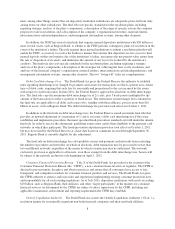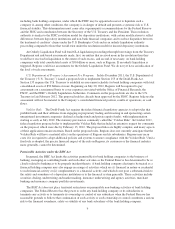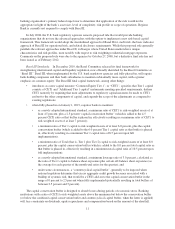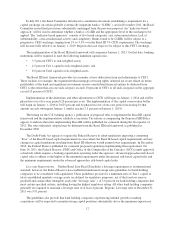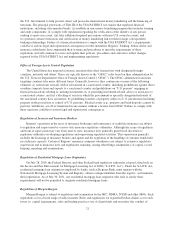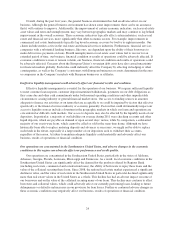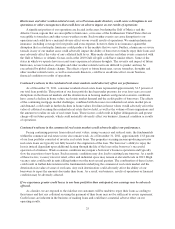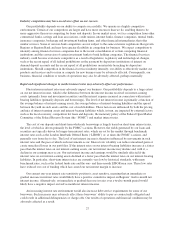Regions Bank 2011 Annual Report Download - page 41
Download and view the complete annual report
Please find page 41 of the 2011 Regions Bank annual report below. You can navigate through the pages in the report by either clicking on the pages listed below, or by using the keyword search tool below to find specific information within the annual report.funds held in noninterest-bearing transaction accounts are fully insured, without limit, and this coverage is separate
from, and in addition to, the coverage provided to depositors for other accounts at Regions Bank. Under the FDIA,
insurance of deposits may be terminated by the FDIC upon a finding that the insured depository institution has
engaged in unsafe and unsound practices, is in an unsafe or unsound condition to continue operations or has violated
any applicable law, regulation, rule, order or condition imposed by a bank’s federal regulatory agency.
Deposit Insurance Assessments. Regions Bank pays deposit insurance premiums to the FDIC based on an
assessment rate established by the FDIC. Regions’ FDIC assessment rates were previously calculated based upon a
combination of regulatory ratings and financial ratios. However, In February 2011, the FDIC adopted a final rule
(the “New Assessment Rule”), which took effect on April 1, 2011, to revise the deposit insurance assessment
system for large institutions. The New Assessment Rule creates a two scorecard system for large institutions, one
for most large institutions that have more than $10 billion in assets, such as Regions Bank, and another for “highly
complex” institutions that have over $50 billion in assets and are fully owned by a parent with over $500 billion in
assets. Each scorecard will have a performance score and a loss-severity score that will be combined to produce a
total score, which will be translated into an initial assessment rate. In calculating these scores, the FDIC utilizes the
bank’s supervisory (CAMELS) ratings as well as forward-looking financial measures to assess an institution’s
ability to withstand asset-related stress and funding-related stress. The FDIC has the ability to make discretionary
adjustments to the total score, up or down, based upon significant risk factors that are not adequately captured in the
scorecard. The total score will then translate to an initial base assessment rate on a non-linear, sharply-increasing
scale. For large institutions, including Regions Bank, the initial base assessment rate ranges from 5 to 35 basis
points on an annualized basis (basis points representing cents per $100). After the effect of potential base-rate
adjustments, the total base assessment rate could range from 2.5 to 45 basis points on an annualized basis. The
potential adjustments to an institution’s initial base assessment rate include (i) a potential decrease of up to 5 basis
points for certain long-term unsecured debt (“unsecured debt adjustment”) and (ii) (except for well-capitalized
institutions with a CAMELS rating of 1 or 2) a potential increase of up to 10 basis points for brokered deposits in
excess of 10% of domestic deposits (“brokered deposit adjustment”). As the DIF reserve ratio grows, the rate
schedule will be adjusted downward. Additionally, the rule includes a new adjustment for depository institution debt
whereby an institution will pay an additional premium equal to 50 basis points on every dollar (above 3% of an
institution’s Tier 1 capital) of long-term, unsecured debt held that was issued by another insured depository
institution, excluding debt guaranteed under the FDIC’s Temporary Liquidity Guarantee Program (TLGP). The
New Assessment Rule also changed the deposit insurance assessment base from deposits to the average of
consolidated total assets less the average tangible equity of the insured depository institution during the assessment
period.
Regions began using the New Assessment Rule for FDIC expense calculations beginning with the second
quarter of 2011. During 2011, FDIC insurance expense decreased $3 million to $217 million. The level of FDIC
deposit expense is expected to fluctuate over time depending on the results of the calculations using the factors
discussed above.
On November 17, 2009, the FDIC implemented a final rule requiring insured institutions, such as Regions
Bank, to prepay their estimated quarterly risk-based assessments for the fourth quarter of 2009, and for all of
2010, 2011 and 2012. Such prepaid assessments were paid on December 30, 2009, along with each institution’s
quarterly risk-based deposit insurance assessment for the third quarter of 2009 (assuming 5 percent annual
growth in deposits between the third quarter of 2009 and the end of 2012 and taking into account, for 2011 and
2012, the annualized three basis point increase discussed below). The FDIC may increase or decrease the
assessment rate schedule on a semi-annual basis.
The FDIA establishes a minimum ratio of deposit insurance reserves to estimated insured deposits, the
designated reserve ratio (the “DRR”), of 1.15 percent prior to September 2020 and 1.35 percent thereafter. On
December 20, 2010, the FDIC issued a final rule setting the DRR at 2 percent. Because the DRR fell below 1.15
percent as of June 30, 2008, and was expected to remain below 1.15 percent, the FDIC was required to establish
and implement a restoration plan that would restore the reserve ratio to at least 1.15 percent within five years. In
October 2008, the FDIC adopted such a restoration plan (the “Restoration Plan”). In February 2009, in light of
17



